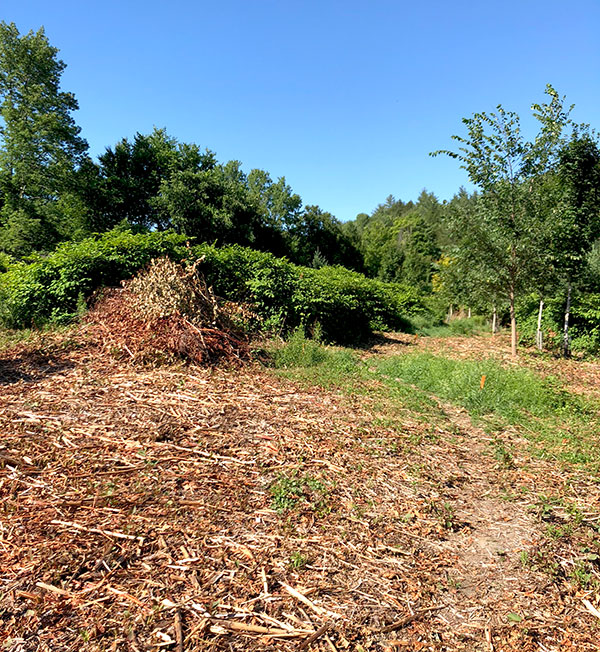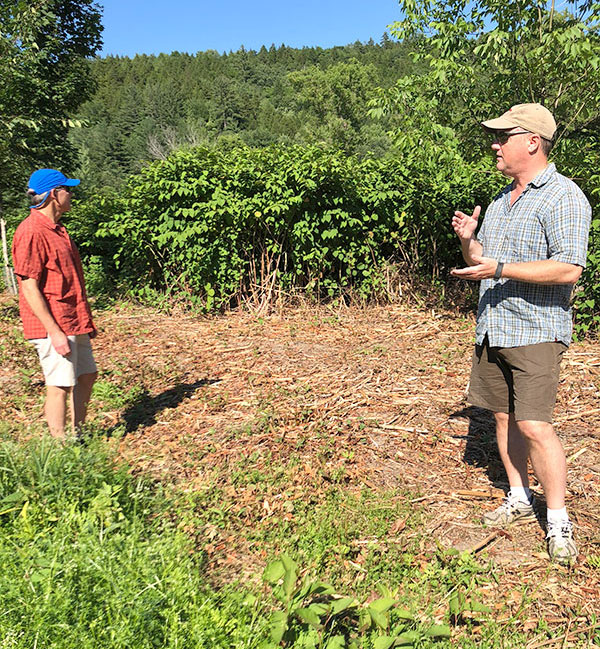On a blisteringly hot Friday afternoon, two members of the Waitsfield Conservation Commission offered a tour of the town’s fledgling efforts at controlling knotweed on a portion of the town-owned Austin parcel.
Accessible via the Lareau swim hole parking lot, the Austin parcel is a long, thin piece of land with a lollypop-like bulb at the end. Conservation commission chair Phil Huffman and commissioner Mark Haberle, who is head of the Conservation Commission’s Invasive Species Working Group, led the way to the knotweed work, through a canopied walk notable for the piles of invasive buckthorn that had been cut and left to dry. In addition to the buckthorn, which is laden with berries right now, invasive honeysuckle is also being cut.
On the long, skinny parcel of the property there’s a wall of knotweed between the river and the other invasives by the walkway. On the rounded part of the top of the lollypop, there’s a mowed loop cut through it and there are large piles of knotweed drying in the sun. The contractor, Intervale Conservation Nursery (ICN), has done an initial round of knotweed cutting and is now cutting again. On the circular trail, it’s plainly visible where the knotweed has been cut several times and is pushing right back up.
ORIGINAL PLAN
 Haberle said that the original plan for the cut knotweed is to wrap it in black cloth on a platform to steam it to death. Another option is to truck it somewhere else, but that increases the chances of small pieces of knotweed falling off and taking root elsewhere.
Haberle said that the original plan for the cut knotweed is to wrap it in black cloth on a platform to steam it to death. Another option is to truck it somewhere else, but that increases the chances of small pieces of knotweed falling off and taking root elsewhere.
Knotweed is an issue throughout the watershed and this project is a trial to see if the knotweed can be contained enough to allow a riparian forest to be re-established.
The Waitsfield Conservation Commission is working with ICN on the invasive plant control demonstration program on the Austin parcel, which borders the Mad River and Mill Brook just north of the Lareau swim hole. The program consists of cutting to remove several kinds of nonnative invasive plants (including Japanese knotweed, honeysuckle, and buckthorn) and, ultimately, replace them with native trees and shrubs. These activities are coupled with site survey work to monitor progress and are complemented with public education and outreach elements.
COMMUNITY VOLUNTEERS
Huffman said that the success of the effort will hinge in part on community volunteers being interested in learning about invasive management best practices and being willing to lend a hand. The holistic program also leverages matching funds and assistance from two local organizations – the Mad River Path Association (MRPA) and Friends of the Mad River (FMR) – to provide additional capacity, expertise and Valley-based experience.
“The goal is to re-align the trajectory of the Austin parcel toward a healthy native flood plain forest, realize the ecological and social benefits of that, and provide an opportunity for local citizens to learn about the challenges of stewarding town lands while engaging in hands-on learning and volunteering,” said Haberle. “This fall a Community Stewardship Day will be held providing an opportunity to tour the site, see the work being done, ask questions, learn from the professionals, and – critically – help remove invasives and plant native species. Please reach out to the commission at any time if you have questions or can simply lend a hand.”
CULMINATION OF SEVERAL YEARS
The project is the culmination of several years of work by the commission and partners to identify an approach for dealing with the infestation of invasive plants on the Austin parcel and re-establish a more natural condition. An initial proposal to combat the invasives using a best practice of targeted, low-dosage herbicides met with considerable community resistance a year ago. As a result, the commission rebid the project last winter with a focus only on mechanical and manual approaches, in keeping with the community’s preference.
“Led by our Invasive Species Working Group, the commission has worked hard to identify a methodology that would prove effective and educational, leverage volunteer engagement, and align with the community values,” said Huffman. “We are pleased to be moving forward with a capable and committed team of professionals from ICN, MRPA and FMR, and are counting on strong community involvement to help make the project a success.”






